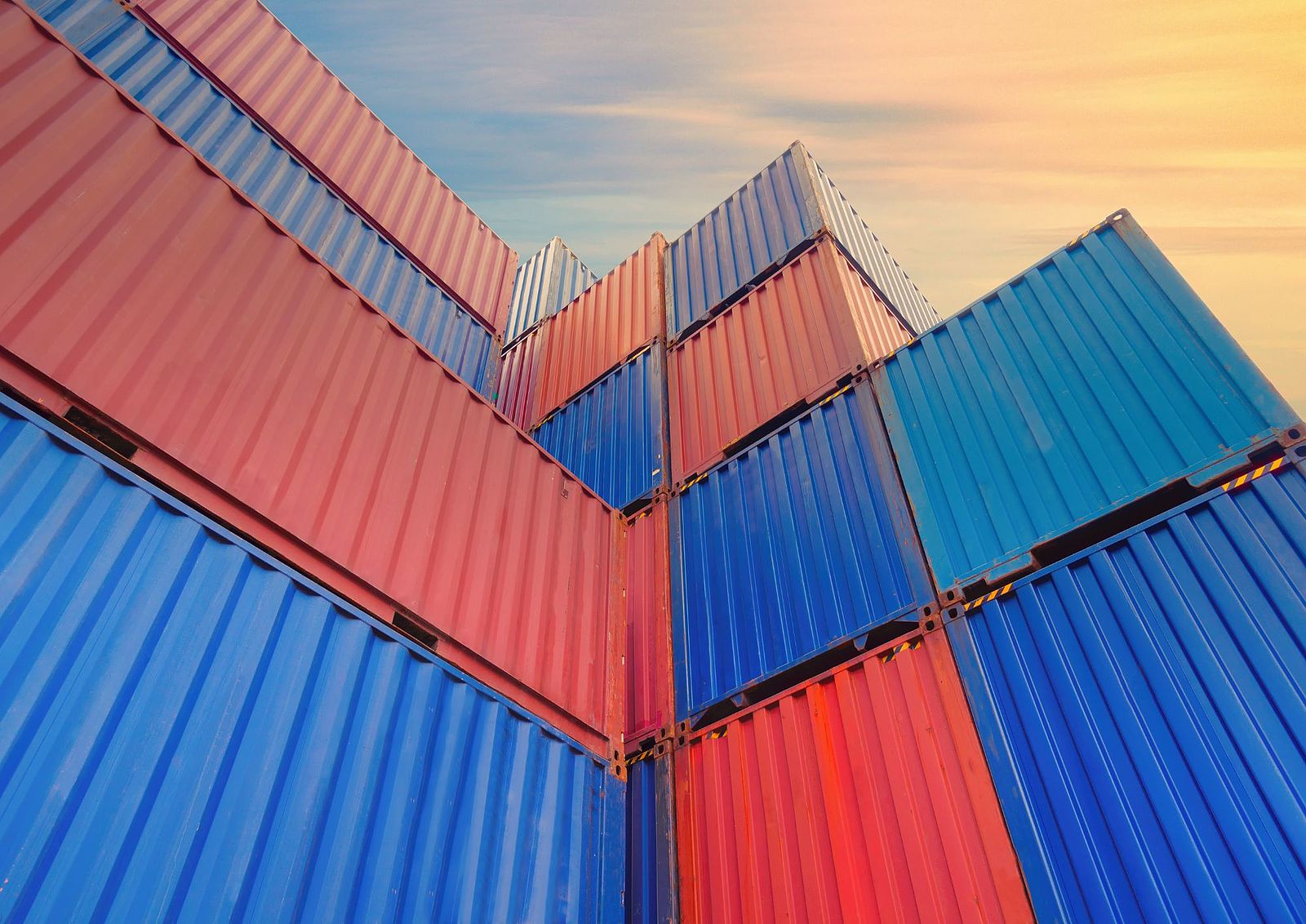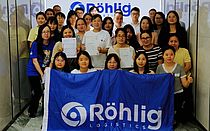Dear Valued Customer,
Welcome to the Röhlig Australia Market Update -August 2022 . We will continue to be in contact with you, letting you know what is happening in the world of freight forwarding and logistics. If you have any questions and would like to address them, please send them to rohlig.australia@rohlig.com. We appreciate your suggestions and feedback.
Please click the links to find out more
Rohlig Australia expands contract logistics operation with a new warehouse opening in Perth Airport, WA.
On the 4th of August, Rohlig Australia officially expanded its contract logistics operation with a new warehouse opening in Perth Airport, WA. The 2.500 square metre facility with 1.500 pallet spaces will enable Rohlig to provide more scalable storage options and solutions, strengthening its integrated logistics services and offerings for customers across the country. Strategically located right next to Perth Airport, the new facility has easy access to key locations, being only 15 kilometres from the central business district and 30km to the Port of Fremantle.
“It is an exciting time for Röhlig Perth to further develop and broaden our service provision to our customer base. We are delighted to extend our contract logistics presence as a response to increasing customer demand in line with a growing economy and logistics industry in Western Australia”, said Michael Cosmelli, Branch Manager, WA.
A special ‘thank you’ to the City of Belmont Mayor, Phil Marks, for attending the opening ceremony and welcoming us in to the local business community: “The City of Belmont is at the heart of one of the most significant logistics hubs for the region and State. This hub supports a high level of activity relating to transport, logistics and goods distribution on a commercial basis by various operators with the aim of becoming a major Freight and Logistics destination in Perth”, stated Mr Mayor. ( See here photos and video from the opening ceremony)
“We are thrilled to open our new warehouse in Perth,” stated Thomas Hansen, CEO of Rohlig Australia & New Zealand. “We have chosen to make a significant investment in our own network in Australia and New Zealand in order to meet our customers’ growing needs. A big “Thank You” to our Western Australia customers for their support over the past years, we are going to serve them even better now”.
For almost 50 years, Röhlig Logistics has been a presence in the Australian market and now has six branches in Australia and three in New Zealand, with more than 250 employees across both countries. We are growing and happy to assist with any Freight Forwarding or Logistics enquiries. Get in contact with our first-class Perth Team if you have any questions regarding our new Perth warehouse.
Oceania in a holding pattern
Not a lot of change since our last newsletter. Flight arrivals into ANZ remain stagnant from last month at around 50% of pre-covid levels. This is not from a lack of demand, as flights inbound and outbound are consistently full of passengers.
Flights are increasing globally, with east-west routes seeing good growth. We expect that demand to be satisfied first before we see additional aircraft through Oceania.
While the situation is an optimistic ally on the improvement, we are not improving in a straight line, with Qantas recently reducing flights due to the ongoing skills shortage in ground handling and airline crew.
Qantas to continue to cut flights amid ongoing airport chaos
Oil and Jet fuel prices
After hitting as low as 87 dollars a barrel, Oil has taken a breather from its recent downward trend. We likely will see some recovery in price over the next few weeks, unfortunately, right into the full re-introduction of the AU fuel levy.
The impact on jet fuel has been helpful over the last few weeks, with significant drops in cost, which we expect now to pause in line with the stabilisation of the oil price. (Click to see the chart).
Australia
Passenger flights are mostly steady since our last newsletter ( bar Qantas per the earlier link ), with no additional freighter capacity. Freighters and passenger flights continue to be at capacity, with some easing in august, expected to rebound again in September.
While no real change has happened in capacity, aviation fuel prices are certainly helping total cost at the moment; we are waiting to see if price rebounds from its recent low.
New Zealand
Trans-Tasman wide bodies still remain in passenger demand, so they will stay around, for now, helping cargo from Australia. We haven’t seen much further inroad from airlines operating from Asia/Europe. There has been some indication that Q4 could welcome additional flights. However, Q1 is more likely, with Emirates indicating Q1 for extra flights specifically due to the staff hiring challenges we’ve discussed before, with Christchurch flights being delayed until Q1 2023.
There has been an uptick in air cargo brought into Australia then moving sea freight to NZ. There are some savings over pure air for this option. Please get in contact with your Account Manager or Customer Service Representative for more information.
Asia
- Asia rates continue to be highly volatile. Yield management with Asian carriers heavily affects rates, as they balance demand from cargo transhipping from other parts of the world to AU, keeping the rate market incredibly dynamic.
- Asian routes will be the last to settle down into normality as we see greater flights arrive. Certain routes, such as Hong Kong, are noticeably higher than average routes out of Asia.
- Shipments are generally on a spot basis, with cargo density being a significant factor as carriers try to maximise KG on their passenger craft. Contact us for any shipments you have, and we’ll look at the best options for you at the time.
USA
- US space remains heavily restricted. However, there has been some ease into August seen elsewhere, though we expect a return to full flights in September.
- A full return of Cathay pacific passengers and freighters still remains key to the USA opening up on space and cost.
- Qantas freighters, servicing New York, Chicago and Los Angeles, are at maximum utilisation, with high costs on these flights, however, they remain effective in moving volume.
- Airline and terminals’ staff shortages are ongoing and not dissimilar in Australia. We’ve been mitigating the delays on this effectively, and hope to see some easing of shortages post the US summer.
Europe
- Europe has been relatively steady, the east coast for AU has not seen the cost decrease that the west coast has, with NZ also keeping firm.
- The strong volume seen in June and July has eased in August, and we expect the ramp-up in volume to push into the end-of-year silly season. It’s unlikely this year’s peak demand will be that of last year, however, we will be prepared in case an unexpected spike does happen.
For more information about our Air Freight services, please click Rohlig Air Freight.
Global Schedule reliability edges higher.
Global schedule reliability seems to have broken the trend seen since the start of this year, with schedule reliability increasing by 3.6 percentage points in June 2022 to 40.0%, according to Sea-Intelligence. “This also marked the first time since the start of the pandemic that schedule reliability improved,” says Alan Murphy, Sea Intelligence CEO.
The average delay for LATE vessel arrivals has been dropping sharply so far this year but remained unchanged M/M at 6.24 days in June. “The delay figure is now firmly below the 7-day mark, and an improvement over the respective 2021 figure.” With schedule reliability of 49.5%, Maersk was the most reliable carrier in June 2022, followed by Hamburg Süd with 41.4%. There were 10 carriers with schedule reliability of 30%-40% and only two with schedule reliability of 20%-30%.
In June 2022, once again, a lot of the carriers were very close to each other in terms of schedule reliability, with 10 carriers within 7 percentage points of each other. On a Y/Y level, nine of the top-14 carriers recorded an improvement in schedule reliability in June 2022, with Evergreen recording the only double digit improvement of 16.2 percentage points.
The situation related to the rail service China-Mongolia that was closed due to severe congestion and long delays at the gateway port for the cargo bound to Ulaanbaatar in Mongolia, has considerably improved. CMA-CGM confirmed that their product rail Tianjin-Ulaanbaatar is now back act.
(Ref: No 31/22 The New Zealand Shipping Gazette, August 13)
Container-ship building spree not over yet - new orders still rising
The price of newbuild container ships keep rising, yet liner operators and ship-owning companies keep placing more orders at Asian yards, guaranteeing an ever-larger deluge of new vessels in 2023-25.
Capacity on order has now reached 27.9% of on-the-water capacity, according to Alphaliner. The ratio was a mere 8.2% at the cycle low in October 2020.
Total capacity on order now tops 7 million twenty-foot equivalent units. The next two years will see major capacity infusions, according to Clarksons Platou Securities: 2.45 million TEUs in 2023 and 2.74 million TEUs — 9.8% and 10.9%, respectively, of on-the-water tonnage.
As orders mount, tonnage for 2025 delivery is rising as well and is now up to 1.13 million TEUs. That’s almost quadruple what was due for delivery in 2025 at the beginning of this year.
“Last week, 13 more container ships were ordered, bringing the total for the year to 239,” Stifel shipping analyst Ben Nolan wrote in a new research note. “This is already the fifth largest year on record for container-ship orders and we are only halfway through the year.”
So why are we now seeing such a busy order book for new tonnage?
One of the reasons is COVID-19 which has seen the carriers profitability soar and they are making historical results.
Carriers are in a strong position to invest in a newer, larger and more fuel effect fleet. They will replace old tonnage and reduce exposure to charter market by increasing their own fleet size. (See PDF file with all charts).
Also with more environmental regulations being implemented, carriers have some pressure to modernise their fleets.
Normally 2-3 years can pass between ordering a vessel to receiving it, so markets can be very different from the day a vessel is ordered to the day it is received. It has always been the challenge for carriers to predict the future demand.
Will we face overcapacity in the coming years? And what options do carriers have to avoid this?
Carriers have improved their ability to control available capacity in trades when necessary. With the influx of new tonnage in the coming years we will have to see how carriers will be able to manage this. No doubt that blank sailings will continue to be an important tool for carriers to match capacity to demand. Unfortunately, this will create service disruptions and we often experience that blank sailing decisions are taken last minute and without any official announcements.
Suspending services for a time period and making vessels idle would be a further step in case blank sailings are not sufficient. Slow steaming is also an option to absorb add capacity and this could also be a requirement from an environmental perspective in the future. Plus not to forget scrapping of vessels which tends to increase in years with over capacity. ( Container-ship building spree not over yet; new orders still rising | Hellenic Shipping News Worldwide)
Oceania
New Zealand
New Zealand ports, including Auckland, Napier and Lyttelton are experiencing high congestion, with the wait time between 6-9 days. This can be attributed to recent weather events, labour shortages and vessels bunching.
Australia
Darwin Port
Darwin Port workers are preparing to take industrial action next week as fair work proceedings unfold and the Maritime Union of Australia and Darwin Port exchange accusations. Members of the MUA, the Australian Maritime Officers Union and the Australian Manufacturing Workers Union are disputing wage arrangements set out in a new employment agreement. Work stoppages and delays are expected from Friday, 19 August.
The MUA said last month that port management had offered workers a wage increase of a little more than 2% after the Fair Work Commission raised the national minimum wage by 5.2% to deal with inflation. The union suggested the increase offered to Darwin Port workers, therefore, amounted to a pay cut. MUA then commenced the balloting process to gauge its members’ support for potential industrial action.
“The ballot for protected industrial action came back with 99.9% support for this course of action from the workforce,” MUA deputy national secretary Warren Smith said.
Darwin’s consumer price index increased by 6% between June 2021 and June 2022, the equal highest increase of all Australian capital cities (alongside Perth). The cost of transportation in Darwin was up 15.3% on figures reported in June last year, and the price of housing rose 11.3% within the same timeframe.
Darwin Port wage dispute escalates to FWC, port workers to strike - Daily Cargo News (thedcn.com.au)
Asia
Most China ports / terminals are back to operating normally. The same for trucking, warehousing etc. We currently do not experience any restrictions, major congestions and delays.
We notice an increase in carrier blank sailings and this will continue into August and September. This will create schedule service disruptions as carriers will have fewer monthly port calls.
Europe
An eight-day strike is expected at Felixstowe Port, UK between 21st and 29th August, amid pay disputes. This will add pressure on already strained supply chain for carriers. Talks between the Unite union and the company that runs Felixstowe port, which were aimed at stopping an eight-day strike by dock workers at Britain’s busiest container port, have ended without a deal.
Negotiations came to an end despite the company’s new offer of a £500 bonus for each of the 1,900 dock workers, who have already voted in favour of strike action between 21 and 29 August amid a pay dispute with the Felixstowe Dock and Railway Company.
The CMA CGM Group upgrades its NEMO Service by adding a 15th vessel into the rotation.
In order to maintain service continuity and improve schedule reliability, CMA CGM Group have decided in a joint agreement with their partner to upgrade the NEMO service with the addition of a 15th vessel in its rotation with the objective to return to the standard rotation and reduce port omissions.
As a result, the CMA CGM ESTELLE will be phasing in London Gateway (GBLGP) on the 17/08/22 and will perform a NEUR rotation – skipping MED.
First vessel to perform standard rotation will be the Northern Javelin with ETD London Gateway (GBLGP) on the 24/08 – ETD La Spezia (ITSPE) on 08/09.
With this additional ship position, the NEMO service will be reinforced as the leading service on the trade from Europe to Indian Ocean and Australia.
USA
NY- NJ ports to impose Container Imbalance fee targeting empty containers
The Port Authority of New York and New Jersey (PANYNJ) will begin hitting ocean carriers with a per-container fee for export boxes that dwell too long at the port. This move is designed to free up space for laden imports that are only expected to grow as peak shipping season approaches.
The ports need to gain control over the volume of empty containers that has swelled in recent years. PANYNJ stated its quarterly “container imbalance fee” will go into effect September 1st following a 30-day public review period. The $100-per-container fee will be applied if ocean carriers don’t remove at least 10 percent of the containers they dropped off during the quarter.
Container Dwell Fee Postponed 2 additional weeks
The ports of Los Angeles and Long Beach announced that consideration of the “Container Dwell Fee” will be held off until August 26th, 2022. The Long Beach and Los Angeles Boards of Harbor Commissioners have both extended the fee program through Oct. 26, 2022. Under the temporary policy, ocean carriers can be charged for each import container dwelling nine days or more at the terminal.
The ports plan to charge ocean carriers $100 per container, increasing in $100 increments per container per day until the container leaves the terminal. This will include loaded and empty containers. The US has experienced a shift in the past several months, as container vessels sought to avoid severe congestion on the west coast and moved increasingly to the east coast. East coast ports have been under pressure, handling higher volumes, longer dwell times and an empty container glut that has caught the attention of the Federal Maritime Commission.
The Port of Baltimore is among the ports dealing with higher-than-normal volumes. While the new business the port has taken on is welcomed, it has also presented challenges, including protests from a small group of owner-operator truckers who object to their long waits to pick up containers.
US imports continue to flood in, but more still arriving at east coast ports
US import container volumes grew by 5.9% in June, year on year, defying weaker consumer demand trends. According to the latest McCown Report, throughput at the top ten US container ports reached 2,164,789 teu last month, after a 3% gain in May and a 5.1% increase in April. This represented a huge, 26.9%, increase on the pre-pandemic levels of June 2019, evidence of the nation’s insatiable appetite for imported goods.
The US east and Gulf coast ports again saw the biggest increase in boxed imports, up 9.7%, to 1,086,380 teu, compared with the 2.3% rise for west coast ports at 1,078,409 teu. Moreover, New York’s 13.4% rise, to 438,553 teu, put the port within striking distance of usurping Los Angeles as the top US container port; the latter showing a decline of 4.9%, to 444,680 teu. Report author John McCown said the coastal shift trend had continued at pace in June, the result being that as many ships are now awaiting berths at New York and Houston as idled at Los Angeles and Long Beach combined. He noted that port congestion contagion had now shifted eastwards, with two-thirds of ships anchored on the east coast, a reversal of the position of six months ago.
“This whack-a-mole effect, where relief on the west coast resulting from deployment changes led to moving some of that congestion to east/Gulf coast ports, is yet another example of the network effects within container shipping systems that have been evident throughout the pandemic,” said Mr McCown. He said it was clear that congestion at US ports was driven by the inability to get boxes out of terminals and not in getting containers off ships.
Meanwhile, the demise of America’s export trade continued in June, with laden containers declining a further 4.1% cumulatively, to 767,823 teu, at the top ten ports. By comparison with June 2019, exports were down 16.2%, and the ratio between imports and exports is continuing to grow; now standing at 2.82, compared with 2.52 in 2021, 2.19 in 2020 and a much healthier 1.85 in 2019. The export decline is attributed to the impact of China tariffs on exports, as well as carriers preferring to reposition their equipment back to Asia due to the spike in headhaul freight rates.”
(US imports continue to flood in, but more still arriving at east coast ports - The Loadstar)
Cargo ships waiting to berth at major USA ports.
Please see the below diagrams that highlight the number of vessels at anchor outside major US ports. On the EC, currently Philadelphia and Charleston are not experiencing as bad a wait time as the other EC ports, although they are still seeing delays due to a knock-on effect. On the WC, interesting to see that the huge backlog of vessels anchored off the coast of Long Beach and waiting to berth from earlier this year has now cleared and there are less than 10 vessels currently anchored. (More information on https://www.marinetraffic.com/ )
2022/23 Seasonal measures for Brown marmorated stink bug (BMSB)
The BMSB season officially starts on the 1st of September.
Rohlig Australia have been strategically preparing for the BMSB season to ensure our customers receive industries best solutions. We offer BMSB treatment and services both Offshore and throughout all Australian states and ports.
This seasons measures are very similar to last, with the main changes being:
- 120 hours policy has been amended for goods that have been rolled.
- Inspect (unpack) Inspections instead of Secure Seals intact inspections at Approved Arrangements
- Emerging risk countries include China and UK only. These countries DO NOT require treatment, however, will be subject to random inspections if:
a. The goods are classified to Chapter 94 and/or 95; and
b. Shipped from China between 1 September to 31 December or the United Kingdom between 1 December to 30 April
Will your Importations be affected by the BMSB Measures?
- Will the goods be shipped between 1 September 2022 and 30 April 2023 (inclusive)?
- Will the goods be shipped as Sea Cargo?
- Have the goods been manufactured in, or shipped from, Target High Risk Countries?
- Are the goods being shipped LCL or categorised as Target High Risk Goods?
If you have answered YES to all the above questions, then BMSB measures will apply to your goods.
To find out more, we encourage our customers to reference the Rohlig BMSB flyer and the Departments guide Preparing to import goods during the BMSB season - DAFF (agriculture.gov.au)
Thank you for your ongoing support of Röhlig Australia and New Zealand. We will continue to keep you updated, however should you have any questions relating please do not hesitate to contact your Röhlig Account Manager or Customer Service Representative.
DISCLAIMER - All information is provided in good faith for guidance and reference purposes only. It is of a general informational nature, and Röhlig Logistics GmbH & Co. KG takes no legal responsibility for the accuracy of the information provided via this document. Röhlig Logistics GmbH & Co. KG makes no representation as to the accuracy or completeness of any of the information contained herein and accepts no liability for any loss arising from the use of the information provided.








